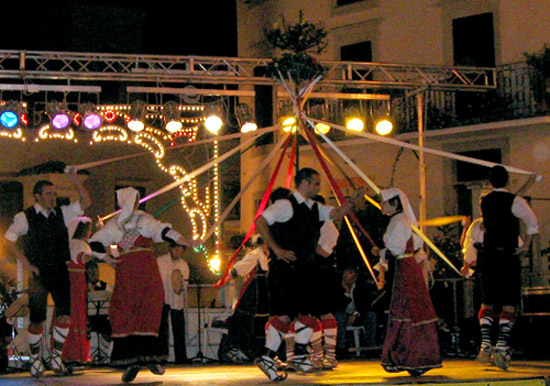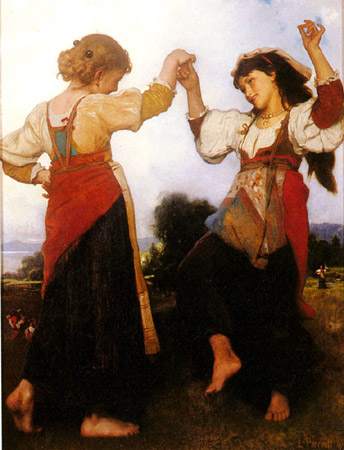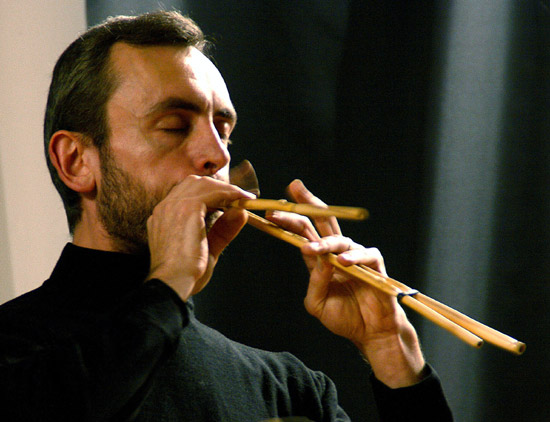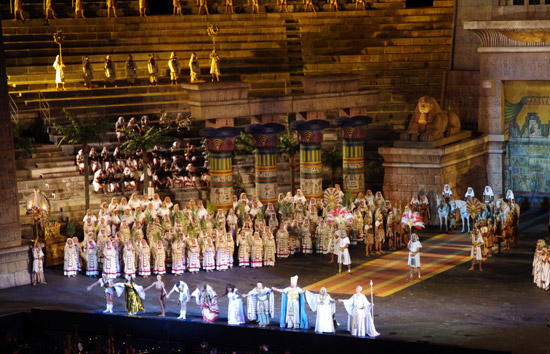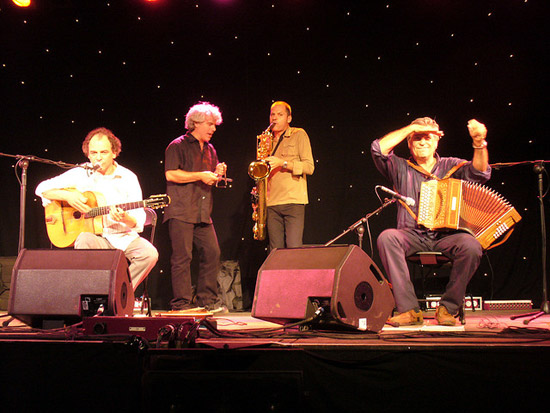Music: Traditional Forms
Folk Songs
Of the many forms of folk music embraced by the various regional cultures throughout Italy, ballads and lyrical songs are the most common. Ballads, known as canto epico lirico, dominate in the north, but are also present in the south. Those of the north are syllabic, follow a strict tempo, and feature clearly vocalized lyrics, while those of the south are characterized by a rubato tempo and more strained vocals. Most ballads are very similar in form to British ballads, but there are some Italian ballads that follow the French form as well. Lyrical songs are most common in Southern Italy and include lullabies, work songs, begging songs, and festival songs.
Epic songs are less common than ballads and lyrics but are an important aspect of the maggio celebration, which refers to the musical and theatrical rituals of planting time in Italy. Ottava rima is a poetic form that was developed by Giovanni Boccaccio in the 14th century, originally inspired by a Sicilian form. It is characterized by eight iambic lines and follows an ab/ab/ab/cc rhyme scheme comprising feminine rhymes. It was the standard poetic form used for Italian epics.
Traditional Music of Central and North Italy
Trallalero refers to the polyphonic musical tradition of Liguria. Traditionally performed by groups of men known as squadre, trallalero is believed to evolved from the harmony singing performed in mountain villages. It features tenor, baritone, bass, and male contralto voices as well as a chitarra, which is a vocal imitation of a guitar. The ideal number of vocalists in a squadre is said to be nine, with five basses and one of each other voice, but squadre can be much larger.
Saltarello refers to the instrumental dance that originated in 13th-century Naples and lives on to this day. Characterized by a fast triple meter, it became popular throughout European courts during the 15th century, was the folk dance of choice in Ciociaria, and became famous in Rome and throughout central Italy. Saltarello music is performed on the zampogna or organetto bagpipes accompanied by a tamborello.
Friuli-Venezia Guilia in northeastern Italy is known for embracing styles from other nations, including the European polka and Polish mazurka.
Traditional Music of Southern Italy
Tarantella, which translates as “little spider,” describes an Italian dance that developed during the Middle Ages. The music is played on the mandolin and is fast-paced and repetitive, escalating as the song continues on. The dance itself is generally enjoyed by groups of people dancing in a circle. Different regions have their own forms of the tarantella—including Naples, Calabria, and Sicily—with Napoletana Tarantella being the best-known.
Canzone Napoletana is a form of traditional music originating in Naples, but whether it can actually be considered true folk music is up for debate. This formally composed romantic ballad developed under the influence of early-19th-century opera and was a popular form of song in its time. Raffaele Sacco’s Te Voglio Bene Assaje was the first canzone Napoletana and it, along with Santa Lucia, popularized the genre. Usually sung by a single male vocalist, the canzone Napoletana is characterized by the Neapolitan language and often comes in the form of a serenade or lover’s song.
The Puglia region in Southern Italy, bordering the Adriatic Sea, is well-known for its brass bands. The brass band tradition developed during the 19th century and was eventually a means of introducing opera and classical music to the rural areas throughout Italy. Eventually brass band music came to be played primarily through Holy Week and funeral processions. Brass bands generally feature trombones, cornets, tuba, and small drums, though clarinets, accordions, and violins may also be incorporated. Banda Cittá Ruvo Di Puglia, based in Puglia, was formed in the 1990s to uphold the brass band tradition.
Traditional Music of Sicily
Sicily, the largest island in the Mediterranean, has a strong folk musical tradition that includes monodic chant and traditional peasant songs. In addition to harvest songs and work songs, Sicilian peasant songs include the lamentazioni, a poetic or musical expression of grief or sorrow. The lamentazioni has a basso ostinato (ground bass)—a repeating motif in the bassline. The Silician monodic chant, known as alla carrettiera, was traditionally chanted while riding a mule home from the fields in the evening.
Traditional Music of Sardinia
Sardinia, Sicily's neighbor in the Mediterranean, is home to the canto a tenore, a guttural form of polyphonic singing indigenous to the island. Traditionally performed by groups of men, canto a tenore features four voices: basso, contra, boche, and mesu boche. It’s performed in a circle, with the soloist singing a line of prose while accompanied by the other voices who enter behind the lead voice. The vocalists hold one ear closed while singing to help them hear the complex harmony. This form is an integral part of daily life in Sardinia, especially in the northern and central parts of the island.
One group upholding this vocal tradition is Tenores di Bitti, which formed in 1974. It includes group leader Daniele Cossellu, who performs both boche and mesu boche voices; Mario Piro, who performs basso; Pier Luigi Giorno as contra; and Piero Sanna as boche and mesu boche voices. The goal of this group over the years has been to revive lost tenore chants.
Elena Ledda is a Sardinian singer also talented at oboe and opera. She has embraced her love for native Sardinian music as the focal point of her career, however, performing worldwide with a variety of legendary Sardinian and international musicians.
A composer and folk music researcher, Alberto Balia is a guitarist who was introduced to the clarinet at a young age. He played in pop and soul groups before later starting to play as a soloist. One of the things he has worked toward as a musician collaborating with others is the revival and preservation of Sardinian musical heritage. His collaboration with Enrico Frongia, Riccardo Tesi, and Daniele Craighead known as Ritmia produced a single recording, Forse il Mare (1987), that remains an outstanding example of modern-traditional Sardinian music.
In addition to the benas, organittu, chiterra, and tamburrinos, Sardinia is particularly known for the launeddas, an ancient woodwind still used in some regions of the island. It is a single-reed instrument made of three different-sized reed pipes—two of which are chanters and one of which is a drone. Each of the chanters features five finger holes; the instrument is played using a circular-breathing technique. The use of the launeddas is strongly linked to the traditional dance of Sardinia.
The Development of Classical Music and Opera
Italy is one of the primary points of origin of classical music and opera as the world knows them today, and both were preceded by earlier forms of music present in Italy. The plainsong, a repertoire of songs that includes Gregorian chant and has long been used in the Catholic Church, was primarily performed by monks between the 9th and 11th centuries. Plainsong is monophonic and unaccompanied, featuring a single line and a relatively flexible rhythm.
Troubadours are known to have performed in Italy since the early 13th century; until the 16th century, most secular music was performed by troubadours and similar performers. The music of troubadours greatly influenced the music of the Trecento period.
The Trecento, at the inception of the Renaissance, is known for being a time of great artistic activity throughout Italy, influencing the development of music and other arts. Instrumental music was common; accidentals were more common in Trecento music than music composed prior to this era. Some characteristics of the time leading up to this period were retained, and some characteristics developed during this period were carried on into the Renaissance.
The Renaissance saw a move from polyphonic music to homophonic music, the result of rejection of over-complicated polyphony and the development of a new musical aesthetic. Renaissance musicians wanted to tell well-known stories, which was simpler to do with homophony than polyphony. Greek myths combined with new, simpler melodies eventually influenced the development of the earliest operas.
Romantic composer Guiseppe Verdi, considered the most important musical figure in Italian history, composed many influential works throughout the 19th century, primarily operas. As a product of the Romantic period, his work is characterized by more serious themes related to human emotion as compared to earlier comedic operas.
Notable Italian Performers
Riccardo Tesi, considered a pioneer of ethnic Italian music, is both a composer and a virtuoso player of the melodeon, a diatonic accordion. His music is respected for having a distinct sound that is simultaneously archaic and modern. Tesi is the founder of Banditaliana, a Tuscan ensemble formed in 1992, and has released music celebrating both folk and classical music of Italy, drawing upon Tuscan and Mediterranean traditions while incorporating jazz and innovative elements. Banditaliana, which features Tesi on accordion, Claudio Carboni on saxophone, Gigi Biolcati on percussion, and Marizio Geri on guitar and vocals, is globally one of the best-known Italian ensembles.
Daniele Sepe majored in flute at the Naples Conservatoire San Pietro a Majella, and picked up saxophone soon after. He spent a solid decade playing classics before seriously composing his own music at the beginning of the 1990s and releasing the very successful recording Vite Perdite (1994) which explored several musical genres and elements.
E’Zezi is a Neapolitan group known for blending folk music and political messages while reaching out to the lower classes. E’Zezi’s repertoire includes music based on traditional Puglian, Calabrian, and Sicilian songs.
Enzo and Lorenzo Fratelli—brothers from Sutero known as Fratelli Mancuso—are known for using acoustic instruments exclusively. They combine elements of the lamentazioni and alla carrettiera that they heard during their childhoods to achieve their unique sound.
Article written for World Trade Press by Cam Waller.
Copyright © 1993—2025 World Trade Press. All rights reserved.

 Italy
Italy 